Harpist Anna Maria Mendieta performs Classical to Tango as a soloist, with orchestras, and with her touring ensembles including: "Tango Del Cielo" (Tango From Heaven) - A multimedia concert! ...
TANGO DEL CIELO
"Tango Surprises From The Sky"
Publication: Suislaw News,
Florence, Oregon
By Burney Garelick
The music was sweet and sad, bowed, plucked, and percussed with refined elegance. Nothing like the sound tango evokes - no sultry, smoldering chords, twisting long limbs in manipulative moves of menace.
If Tango del Cielo's music was pretty, tango dancer Count Glover's countenance smoldered with enough dark intensity to shake the continent of South America, spilling tsunami waves in all directions. Flamenco dancer Fanny Ara was equally chilling, clicking castanets and stomping the stage giving rise to the phoenix. Count and Fanny attempted to dance with each other but were both put off and exited at opposite sides, two titans of terror unwilling to engage each other. Count plucked harpist Anna Maria Mendieta from her instrument and put her through intricate twists and turns, after which he dropped her at her harp and fled the stage. Sometimes he danced by himself, pleased at last to find a perfect partner.
Anna Maria, however, knew what to expect and expertly dodged bullets that would send anyone else to a chiropractor. Anna Maria is genetically coded for tango; her great aunt danced in Rudolph Valentino's silent movie classics.
Tango del Cielo, an ensemble from California and Seattle, performed April 13 at the Florence Events Center, the penultimate concert in the Seacoast Entertainment Association 2011-12 season series. The four musicians celebrated traditional tango and flamenco using classical instrumentation violin, cello, and harp and extraordinary percussion, all arranged with complementary precision. Much of the program of Latin music was drawn from the work of Astor Piazzolla.
Readily recognizable pieces included "Jalousie," "Granada," and "Malagueña." Dancers accompanied some of the pieces. "Danse Espagnole from La Vida Breve" by Manuel de Falla and transcribed for violin by Fritz Kreisler was a literally moving duet between flamenco dancer Fanny and violinist Thomas Yee. Thomas is an excellent violinist, and his fiddle, previously owned by the great Isaac Stern, has a sublime tone, even when it is tasked to imitate crickets.
The innovative group provided other surprises, including video clips on a large screen of Valentino films and colorful artwork to accompany the music. At the start of the second set, the group performed its own silent film against an elaborate stage set. The Count sat at a cafe table drinking wine and feverishly writing a music score. Percussionist Antonio Gomez was a put-upon waiter. Anna Maria arrived to discover the composer's score and played it on her harp. She showed the score to cellist Joseph Hebert who turned it right side up or upside down and played it on his instrument. Thomas appeared wearing a black fedora and toting his cased instrument like a gangster's weapon. 'Twas truly a tango film noir!
Drum solos in any genre are always exciting, but Antonio's "Madera y Cuero" was mesmerizing. He had no traditional drum kit; he sat on a box drum and combined bongos, cymbals, shakers, rattles, a rainstick, and all manner of percussive implements. The string instruments joined in with exotic sounds, enveloping the listener in a tropical landscape by painter Henri Rousseau arranged by John Cage.
Tango del Cielo delivered an innovative and surprising performance of tango and flamenco music. Rain isn't the only thing that falls from the sky!
Press
Album Review - TANGO DEL CIELO - Anna Maria Mendieta, harp, and orchestra.
(external link)
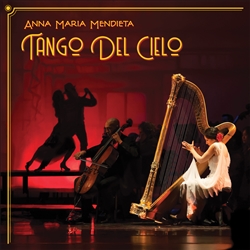
THE HARP COLUMN MAGAZINE - Jan/Feb Issue
Recording Review by Alison Young
TANGO DEL CIELO - Anna Maria Mendieta, harp, and orchestra.
California native Anna Maria Mendieta was raised on music and dance, playing for years as a featured soloist with Theatre Flamenco of San Francisco. It wasn’t until 2004, that she discovered the thrilling world of tango, her gateway drug to the complex and feverish music of Astor Piazzolla. But to make this music her own would require not just arranging music for the harp, but acquiring some new techniques like chicchara to mimic the sizzling and aggressive technique of authentic tango orchestras.
In her latest release Tango del Cielo, Mendieta, along with a superb lineup of musicians, serves up all the fiery passion of this exceptional culture in superb form. Designed as a multi-media stage show with live dancers, the music arranged by multi-Grammy-award-winning composers Jorge Calandrelli, Pablo Ziegler, and Daniel Binelli transports the listener to the dimly-lit, smoke-filled chambers of mid-century Buenos Aires and the Old World, where the roots of this music can be found.
So it makes sense to include Asturias by Isaac Albéniz, where Mendieta displays her natural ensemble gifts, as if dancing with the orchestra. She leads as soloist, always coaxing a close, cheek-to-cheek partnership. Particularly stunning is the addition of castanets and Flamenco stamps and taps to the mix. You’ll be afforded a special opportunity to hear Mendieta shine in Ziegler’s mesmerizing Milonga en el Viento, a work he initially explained would be practically impossible on the harp because of its never-ending chromaticism. It would seem Mendieta never met a challenge she couldn’t conquer; she manages 200 pedal changes in order to share this richly elegiac work with us, a centerpiece of the album.
The album opens with Libertango, one of Piazzolla’s most famous tangos, and one that signaled his break from “music for the feet” and ushered in an era of Argentine concert music. That being said, it will be hard to sit still while listening to this arrangement by the exceptionally talented violinist and leader of Quartet San Francisco, Jeremy Cohen. Cohen’s violin styling also shines with raw flamboyance in Bordel 1900 as well as the dramatic Jalousie by Jacob Gade, a work from the silent film era in which Cohen plays a violin owned by the concertmaster of the MGM Orchestra and played in dozens of films during the Golden Age of cinema.
A work almost out of character, as though a palette cleanser, is the stunningly simple yet heartbreaking Ave Maria by Piazzolla. Arranged as a harp solo, Mendieta’s tender interpretation is dedicated to her deceased father. She’s joined midway through by cellist Joseph Hébert, improvising as if answering her prayers for peace. It is one of the most stunning moments of the recording.
Rounding out the album is sheer genius, beginning with a short work Tientos, a short work by Raoul Laparra originally written for chromatic harp, an instrument invented in Spain in the late 16th century. The solo arrangement for pedal harp affords Mendieta the chance to contrast the simplicity of the chords with the raucous, needing-to-bust-out quality of Latin music. She uses this short work to lead directly into the finale, an original Malagueña-Milonga that brilliantly fuses flamenco and tango for an explosive finish.
A sensational journey of rhythm and sound, Anna Maria Mendieta’s Tango del Cielo will continue to intrigue over many listenings.
INTERNATIONAL MUSICIAN - Featured Story
(external link)
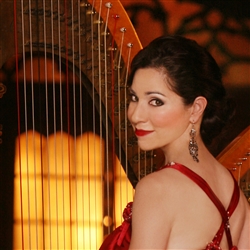
INTERNATIONAL MUSICIAN - Magazine/Newspaper
American Federation of Musicians
February 1st, 2021
CLASSICAL HARPIST TREADS NEW PATHS PLAYING TANGO
Featured Story by Megan Romer
Anna Maria Mendieta has no trouble recalling the dayspring of her lifelong love affair with the harp. At age five, her arts-loving parents (her mother was a pianist and accordionist; her father played classical guitar and saxophone) played a recording of Tchaikovsky’s Romeo and Juliet, and the overture swept her away.
“They told me the story of Romeo and Juliet and I remember being so amazed because you can really hear it in that music, and there’s this moment where everything becomes silent and all you hear is this beautiful harp. And that’s when I knew: That’s what I want to play,” she says. “I sat there with my ear right up to the speaker and I had them play the recording for me over and over again.”
Unlike Shakespeare’s infamous star-crossed lovers, Mendieta’s love was requited not too much later. Her parents started her on the piano while they figured out the logistics of harp studies and found her a teacher. “My father was a great collector of instruments. He had all sorts of things, even a harpsichord! But no harp,” she says. By age seven, she had begun studying the Salzedo method with Israeli harpist Efrat Laury-Zaklad at the San Francisco Conservatory of Music. “I took my first lesson and I knew; clearly, there was never any wavering from that.”
The towering physicality and visual beauty of the harp—and the highly-aesthetic Salzedo method in particular—have always been part of the appeal for Mendieta. The visual sleight-of-hand that keeps the audience’s eyes on the graceful gestures of the arm and away from the foot pedaling action that determines the harp’s key is a dance in itself. (“Now you know the secret to the long gown,” she slyly whispers.) For her, the connection with dancing offers a certain familiar comfort: alongside their musical studies, Mendieta’s parents encouraged their children to study dance. The family’s Spanish heritage made flamenco an important point of cultural connection (one of her sisters is a professional flamenco dancer), but it was after Mendieta’s career as a professional harpist was well-established that she found a new love: the tango.
Like so many people, Mendieta found the tango through the compositions and performances of revolutionary Argentinian composer and virtuoso bandoneon player Astor Piazzolla, whose nuevo tango style changed the face of both classical music and tango. Falling in love with the music and its accompanying dance, Mendieta sought out harp arrangements of Piazzolla’s work. Finding none, she wrote directly to Pablo Ziegler, Piazzolla’s former pianist and the preeminent composer and performer of nuevo tango, to see if he had anything that might work. No luck. “I said, ‘Just send me what you have and I’ll figure out how to play it,’” she says.
“People told me it wouldn’t work, there was just no way. ‘You can’t play tango music on a harp, it’s too chromatic,’ they said. And it was a real challenge,” Mendieta recalls. “Astor Piazzolla’s music is so incredible. He uses his instruments not only as melodic instruments but as rhythm instruments. It took me many, many years to figure out how to do that on the harp. I had to change my technique in order to get the sounds. To play the chromatics, I figured out different ways to bend the notes.”
Mendieta realized that the methods used by jazz harpists to use the pedals of the harp strategically to create slides and slurs could provide a basis for this new technique. This, of course, went against everything she had ever learned about the pedals: be as gentle and quiet as possible so as not to lose the clarity of notes; move feet with subtlety so as not to distract from the hands. Suddenly, she found herself using the pedals like a pedal steel guitar player would: bending her notes in real time while also getting creative with enharmonics, using them to substitute for chromatics when an extra note was needed without a pedal change. “I was also incorporating percussive sounds, like the chicharra sound of the violin [a method of playing the violin string above the bridge for a cricket-like percussive effect], but I had to figure out how to make all those imitative sounds. I just basically made it all up,” she says.
Mendieta’s creativity in making the tango work on the harp resonated with many of Piazzolla’s former orchestra-mates and contemporaries, who found echoes of Piazzolla’s own rule-breaking in this new tango frontier. Mendieta has played with a number of these musicians and has spent significant amounts of time in Argentina both studying and teaching, alongside names like Pablo Ziegler, Javier Cohen, and Daniel Binelli.
A surprising moment in Mendieta’s touring concert and show, “Tango del Cielo,” comes when the male principal dancer walks over to the harp and takes her hand, leading her to the dance floor. “Oh, the audience loves that, they really don’t expect it,” she laughs. Learning to dance the tango was, for Mendieta, crucial to understanding the deep feeling and rhythms of the music.
Even as she treads new paths in the tango field, Mendieta has not abandoned the music that made her fall in love with the harp in the first place, as the harpist for the Sacramento Philharmonic and Opera and a fixture throughout the California classical scene. Her work with the Sac Phil, along with regular performances in San Francisco and Los Angeles, has made her a rare AFM triple-carder: Local 12 (Sacramento, CA), Local 47 (Los Angeles, CA), and her original Local 6 in San Francisco, with whom she first signed on as a teenager.
Union membership has not only afforded Mendieta performance opportunities, networking, a safety net, and the knowledge that there were people who had her back, but also a wealth of opportunities to develop personally as both a performer and a business professional through the extensive continuing education programs on offer. “Local 47 in particular has that great new building and they offer so many interesting workshops—all kinds of things, from technology training to tax information, as well as every kind of music you can imagine.”
With COVID threatening the livelihoods of so many artists (and the venues in which they play), Mendieta sees the AFM as crucial in helping musicians stay connected, sharing ideas and inspiration and outside-the-box thinking, and lobbying for survival.
Personally, Mendieta spent the shutdown finishing the Tango del Cielo album that she’s had on the back burner for years. It was partially completed but never quite finished due to near-constant performances and teaching.
“I just had not found the time to finish it,” she says. “So early on, when it seemed like things might be closing for a week, maybe two, I decided to take the opportunity to go into the studio and finally finish recording my parts, and I’m so glad I did because mixing them—which I did digitally with my producer—gave me something to do in those early weeks, and I did finally get the whole thing finished and released!”
TOOLS OF THE TRADE
Lyon & Healy harp (Salzedo Model)
Horngacher harp
Premier Harp Strings (“I like the clarity of their strings.”)
Portastand Minstrel music stand (“It’s so lightweight, it’s solid and sturdy, plus it’s small so it doesn’t block the sightlines of the harp during performances.”)
March 6, 2020 "ANNA MARIA MENDIETA BRINGS TANGO TO HARP MUSIC"
(external link)
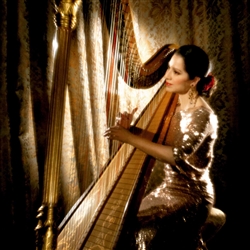
- CENTERLINE NEWS -
___________________
ANNA MARIA MENDIETA BRINGS TANGO TO HARP MUSIC
March 6, 2020
- Jim Bessman
(Photo: Anna Maria Mendieta at APAP)
Award-winning concert harpist Anna Maria Mendieta is bringing tango to the harp music canon.
The San Francisco-based principle harpist with the Sacramento Philharmonic & Opera, just back from an intense schedule in Boise with Opera Idaho, was at the recent Association of Performing Arts Professionals (APAP) conference at New York’s Hilton Hotel Midtown, where she promoted her show Tango Del Cielo (Tango of Heaven), which features tango and flamenco music and dance.
And in celebration of the new decade, the show also features a special tribute to “the Roaring 1920s and the Silent Films.”
“We have lots of fun turning the clock back to the Golden Age of Hollywood, since it was through the silent films that tango was first popularized in the United States,” says Mendieta, who has performed in pop programs with the likes of Andrea Bocelli, Josh Groban, Johnny Mathis, the Moody Blues, Frank Sinatra Jr. and Barry Manilow.
She cites specifically the movies of Rudolph Valentino among other great silent film stars.
(PHOTO: Rudolph Valentino and Nita Naldi in "Blood and Sand")
“My Great Aunt Nita Naldi was Rudolph Valentino’s co-star for so many movies that she was known as the ‘Female Valentino’! She is seen in many movies with him, but one in particular is quite fascinating: In [the famous film in which he played a matador] Blood and Sand, she is seen playing the harp for Rudolph, which was how she stole his character’s heart away from the bullfights, his career as a matador, his fans--and his wife. The funny thing is that I never knew she played the harp! When growing up, my grandmother would always talk about my relative Nita Naldi in the silent movies. But I was too young to appreciate it, and never knew she was Valentino’s co-star until a few years ago when I was doing a different version of the show and wanted to feature old tango scenes from the silent films.”
The current Tango Del Cielo is a multimedia concert with harp, strings and percussion, showcasing the tango, flamenco, classical and jazz music and dance of Latin America and Spain—also with film art, lighting effects, backdrops, sets, props, and vignettes, and also featuring award-winning Argentine tango and Flamenco dancers.
“Many of the famous tangos we know today were composed for movies like The Mark of Zorro, with Douglas Fairbanks & Lupe Valez, and the films of Valentino and Nita,” notes Mendieta. “Tango Del Cielo connects history with the present, tradition with innovation. It’s entertaining, educational, and appropriate for all ages.”
Mendieta has long specialized in Spanish music for the harp. Her ancestry is from Spain and Mexico, and she’s performed for the king and queen of Spain in California at the best of the Spanish Consulate, as well as at National Hispanic Week festivities in Washington, D.C.
But she credits the late Argentine tango composer/bandoneon player legend Astor Piazzolla for her deep and pioneering dive into tango back in 2004.
“I fell in love with his music and started looking for arrangements--and couldn’t find any!” says Mendieta, who was told that she couldn’t play tango on the harp anyway, as it was musically “too chromatic.”
“So I had to create my own arrangements, and now a lot of harpists play tango music.
She even met some of Piazzolla’s musicians, who created other arrangements and composed new music for her.
“His music unites everything—tango and Latin rhythm with contemporary classical and jazz elements,” she says of Piazzolla. “The harp was always considered a dainty teatime instrument, but it’s so much more: It’s not just melodic, but also a percussive instrument—and being a classically-trained musician, playing tango was very freeing.”
Mendieta did have to adapt her technique to playing it, though.
“I had to achieve a ‘power bass’ sound, and ended up with bruises up and down my arm! At first it was very, very hard, but I soon figured out a shortcut and was able to do it.”
Mendieta has released an EP, Del Cielo!, featuring the music of Argentina and Spain with harp and orchestra, in advance of a full album, due later this year. It will be the first album of Argentine tango music for harp and orchestra.
“It was recorded at Skywalker Sound, and has compositions and arrangements by some of Piazzolla’s musicians,” she says, citing his Grammy-winning regular pianist Pablo Ziegler, also Jorge Calandrelli: “He’s won six Grammys and looked up to Piazzolla as a mentor! He arranged our version of Piazzolla’s ‘Oblivion.’”
(PHOTO/VIDEO: "Tango Del Cielo" show reel)
Article Published: March 6, 2020 Centerline News - Jim Bessman, reporter
"TANGO DEL CIELO" presents a captivating blend of music, dance and media, San Francisco, CA
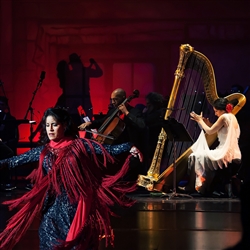
TANGO DEL CIELO
Sunday, June 4th at 3:00 pm
MARINES' MEMORIAL THEATRE
609 Sutter Street
San Francisco, CA 94102
TANGO DEL CIELO presents a captivating blend of music, dance and media
including tango, flamenco, Spanish classical and Latin jazz!
Evoking Argentine cafes of the 1920s, the open country of Spain and even the lush Amazon forest, Tango del Cielo – or “tango from heaven” is a sonic and visual feast.
Framed in the imaginative and cross-cultural setting from which tango first emerged in Buenos Aires, the program pays homage to its musical heritage even as it playfully challenges expectations.
In Tango del Cielo, Anna Maria Mendieta found the perfect intersection of her artistic passions and family heritage. A San Francisco native, Sacramento Philharmonic principal harpist and tango dancer she creatively inserts innovative harp technique where instruments like the bandoneon or guitar typically hold sway. Tango del Cielo serves up novel interpretations of music by composers from Astor Piazzolla to Spanish masters de Falla, Albeniz and Rodrigo, not to mention jazz great Chick Corea.
The concept found fertile ground in the enthusiastic embrace of Grammy-winning tango maestro Pablo Ziegler (pianist of legendary Astor Piazolla) and Jeremy Cohen (Quartet San Francisco) who have contributed innovative arrangements especially for Anna Maria.
An intriguing gathering of musicians and dancers contribute to the imaginative project: Cellist Joseph Hébert (East Bay Symphony and Skywalker Symphony) moves seamlessly between classical rigor and jazz sensibilities, anchoring the ensemble with deep, rich tonality. Expressive violinist Matthew Szemela sizzles with the same energy he has brought to projects ranging from Jay-Z and Lana del Rey to opera and Balkan music. Seattle percussionist Antonio Gómez splits his energies between Afro-Latin genres and the early music of the Mediterranean, employing instruments from around the globe to create fresh arrangements and evocative sounds. Award-winning dancers Suzanne Mendieta and Marcelo Molina embody raw emotion, smouldering passion and delicate expressiveness with contrasting flamenco and tango vocabularies. Molina is an Argentine dancer residing in California and a recent U.S. National Tango Champion. L.A.-based actor/producer Bill Mendieta uses visual elements and vintage film to invoke the silent-film era classics which first introduced U.S. audiences to tango (and which featured the Mendieta’s great aunt opposite stars like Rudy Valentino).
Tango del Cielo tours nationally - both as a self-contained ensemble and as a guest element for symphony-orchestra programs. While the Bay Area is home to most of the group, appearances in San Francisco are a rare treat and are sure to be unforgettable.
The concert and a silent auction will support a new project in which Anna Maria Mendieta and Tango del Cielo are working with arranger Jeremy Cohen and the studios at Skywalker Ranch to present new orchestral settings of Tango del Cielo's wide-reaching repertoire.
Tickets range from $35 (students/seniors) to $75 (VIP champagne reception) for this all-ages appropriate spectacle of music and dance.
"A dance of relation: Argentine music and dance concert stretches the envelope!", Ukiah, California
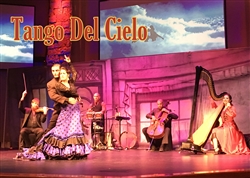
ANNA NARIA MENDIETA - Moving force behind Tango Del Cielo
by Roberta Werdinger
The Dances of Argentina, the third concert in the Ukiah Symphony Orchestra's 2016-17 season, will be presented at the Mendocino College Center Theatre on Saturday, February 11 at 8 p.m. and Sunday, February 12 at 3 p.m. The concert will present a rich panorama of Argentine culture, beginning with harpist and impresario Anna Maria Mendieta performing Alberto Ginastera's Harp Concert, Opus 25 accompanied by the Ukiah Symphony under the direction of conductor Les Pfutzenreuter, followed by a performance by tango master Marcelo Molina along with a surprise guest, and concluding with the orchestral suite Estancia: Four Dances, Opus 8A, also by Ginastera.
"We are very thankful to be in Ukiah again," Anna Maria Mendieta says. The Bay Area harpist swung through town last year with her national touring group, Tango del Cielo ("Tango of Heaven"). Undaunted by her long list of credentials—she's played for a pope, presidents, and celebrities, on stage and screen, and had concertos especially commissioned for her—Mendieta's primary arc could be described as stretching the envelope: extending a tradition she loves by innovating in it. For example, hearing the music of Astor Piazzolla, the famed tango composer and musician, she thought, "I would love to play that on the harp." When people scoffed at the idea, she was even more determined. "When people tell me something can't be done, it makes me do it even more. I started creating my own arrangements," she recalls, which were performed for the National Harp Conference in 2006 and were highly influential.
Mendieta believes that musicians and dancers exist in a long line of both tradition and innovation. "We're seeing a progression here," she observes, noting how Ginastera "stretched the envelope" in the Harp Concerto, making use of percussive sounds & rythms that reflected the indigenous traditions of Argentina. Piazzolla, a student of Ginastera's, greatly extended the range of tango music by incorporating influences from jazz and classical realms, so much so that his music was played more in other countries than in his native Argentina at first. (They later earned widespread acceptance.) After Piazzolla died in 1992 one of his band members, Pablo Ziegler, enjoyed a fruitful solo career without the use of the bandaneón, an accordion-like instrument commonly used in tango—despite people's claims that tango music couldn't be played without it. After Ziegler won a Grammy for best tango album, Mendieta asked him to create special arrangements for her. Of the experience, she says, "It was an incredible experience and an honor to work with him. Much of the style cannot be put into writing. It has to be passed on."
Mendieta became so interested in the tango form that she eventually learned the dance, traveling to Argentina to do so. She might make an able partner for Marcelo Molina, who will be featured in the dance portion of the show. Hailing from Córdoba, Argentina and trained there and in the nation's (and tango's) capital, Buenos Aires, Molina now makes his home in Fresno. Lucky Californians get the benefit of Molina's unique grace and strength as a performer and as a choreographer, which have earned him two first place awards in international tango championships in Buenos Aires [not sure, perhaps see Marcelo's bio above for correct wording]. Molina has also toured the U.S. with Mendieta's Tango del Cielo group, as well as with other tango ensembles.
Tango—as movement and as music—is, first and foremost, about relationship. The partners, traditionally a man and a woman, make close contact and move together, connecting at arms' length, or at the chest or the hips, depending on the style of tango. Feet are kept close to the floor, lending the form a sultry feel, except for moments of sudden grace when the male or the female partner may kick their leg up, sometimes even (in the female's case) landing it around her partner's neck. While the man is designated as the leader and the female as follower, in the best tango dances a spirit of joy, play, and respect comes forward as the two explore the parameters of their partnership.
Tango has now taken root in many countries. Devoted dancers and musicians import Argentine teachers and travel there to learn the form, while also adapting tango to their own culture. Molina notes, "We dance how we are as a society." There is American-style tango, Uruguayan tango, even Finnish tango. As tango continues to evolve, new art forms will evolve from it. What is constant is the sweat necessary to make a graceful gesture, and something that cannot so easily be put into words. As Molina puts it, "Tango is not just about physical contact but about hearing the soul of the other person."
Argentina, like America, is a young country that has produced cultural forms reflecting the rawness and grandeur of its frontier. While America has cowboys, Argentina has gauchos, who worked the ranches and managed the large cattle herds there. All this is evident in the last part of the concert, where the orchestra returns to play Ginastera's work Estancia: Four Dances. "Estancia" means "ranch" in Argentine Spanish; Ginastera built the work around a love story that takes place among the gauchos, presenting it as a four-part orchestral work in 1943 and in 1952 as a ballet. Rippling with the rhythms of traditional Argentine music as expressed through the grace and elegance of the European classical tradition, the piece builds to a rousing conclusion with the last movement, “Danza final (Malambo)." Malambo is an indigenous-derived dance that arose on the pampas (grasslands) of South America. Danced by men--sometimes wearing gaucho boots--to prove their prowess, the percussive quality of feet stamping on the earth will be reflected in the vigorous playing of the orchestra.
The Dances of Argentina is sponsored by Rich & Jean Craig, Savings Bank of Mendocino County, and Selzer Realty/Realty World.
"Renown Harpist Comes To Ukiah", Ukiah Daily Journal, California
(external link)
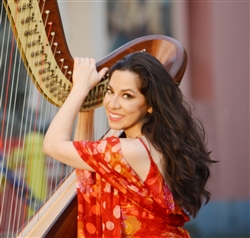
RENOWN HARPIST COMES TO UKIAH
By Carole Hester, for The Ukiah Daily Journal
Concert harpist Anna Maria Mendieta is a soloist, orchestral musician, recording artist and teacher. She is the principal harpist with the Sacramento Philharmonic and has performed as a soloist and as a member with many symphony orchestras and chamber music groups across the country.
She has received international recognition as “an exceptional soloist” by the American League of Symphony Orchestras for her performance of the tango music of Astor Piazzolla, making history with the unique programming and use of harp in this musical style.
She has played before kings and queens, popes, governments and other international dignitaries — and she’s coming to Ukiah.
Mendieta’s exciting new project “Tango del Cielo” (Tango from Heaven) is a fresh and innovative presentation of the passionate and sensuous music of the Argentine Tango and Spanish Flamenco. Bringing together harp, strings, percussion and dance, “Tango del Cielo” features a fusion of many Latin styles, including Argentine Tango, Flamenco, Spanish Classical and Latin Jazz.
“Tango del Cielo” concerts are especially entertaining, incorporating multi-media use of film art, staging, lighting and effects.
She is the featured artist at the next Ukiah Community Concert Sunday, Sept. 18, at 3 p.m., in the Mendocino College Center Theater. Tickets at the door for $30; and also at Mendocino Book Company, Dig! Music and Online at www.ukiahconcerts.org.
“The harp is rarely used in tango music unless to join the orchestra, in which it would provide typical harpistic effects like a glissandi or arpeggio here or there. When I began, there was absolutely no sheet music for the harp in this genre. I’d go to the music store and collect any tango music I could find, even if it was for the flute, guitar, bandoneaon, anything…I was told by so many that it just can’t be done on the harp; the tango music is too chromatic. Well, if anyone tells me I ‘can’t,’ then I become even more driven to prove them wrong.
“I was intrigued by the intense rhythms of Piazzolla’s music…not an easy task on a harp, which requires some very creative playing. I realized I had to invent my own technique. I experimented with pedal slides (pedals allow the harp to change key and produce sharps and flats). I experimented with sound effects and percussive sounds.
“I tried to imitate the strong, present, driving sound of the upright string bass, and the whistles and chichara effects of the violin (scratchy sounds to imitate cricket noises) It took time and I still consider it a work in progress, but I love it and I love a challenge.
"In 2005, in order to understand tango music better, I took tango dancing lessons. What an eye opener! The music now made sense; I was learning how to be grounded and connect with the earth. We, as musicians also have to become like dancers and be so intuitively sensitive to one another. I met amazing Grammy award winners and the top musicians in the tango world who became intrigued with the challenge of harp and tango.”
Mendieta was fortunate in that her grandmothers were always with her as she grew up. Her Mexican grandmother lived with the family until Mendieta was 18 and spoke only Spanish.
“We’d see my Guatemalan grandmother four times a week, as she would come over to help my mother with the kids or the laundry. With six kids in the house, I’m sure my mom needed help. Both would cook, tell stories and share their cultures with us in many ways. And what stories indeed!
“I’m an old movie buff...I absolutely love old movies! When I was little, I would stay up late to wait for my father to come home from work (he worked the late night shift at the SF Chronicle Examiner). When he got home, we’d stay up and watch the old late night movies together with any other family members who could manage the late night.
“Since then, I grew up fascinated with film history, but, to my surprise, I did not know that one of my ancestors was a great silent film actress. When I was young, my grandmother would always tell me that we had a relative who was in the silent movies, but I just thought it was someone in LA who was an extra in the movies.
“She would tell me the name and correct my mispronunciation. I was young and foolish, and just didn’t give it any attention. Unfortunately, after my grandmother passed away, we all forgot about it.
“I only found out a few years ago by accident that the person she was telling me about was the woman who co-starred most with Rudolf Valentino. Her name was Nita Naldi. She was one of the first great silent film vamps. She had a long list of big movies and many with Valentino, so much so that she was known as the ‘Female Valentino.’
“For many years, I’ve incorporated a tribute to the silent movies in the show because it was through the silent movies that tango was brought to the U.S. It was Rudolf Valentino and his famous tango in the opening scene of the ‘Four Horsemen of the Apocalypse’ that caught the attention of American movie goers and won Valentino overnight stardom.
“It was about five years ago that I asked my brother, who’s an actor and movie producer in LA (and our stage director), to create a film montage of the tangos from the silent films. I wanted a short film clip to give us musicians time to change into vintage costumes and give the audience a little history of tango in the U.S. He created a great film. I saw it once and that was it – I was always changing costumes while it was played.”
Mendieta began studying the harp at the age of 7 at the San Francisco Conservatory of Music with Israeli harpist Efrat Zaklad. Later she continued her studies with Marjorie Chauvel of Stanford University, and received her degree in Music with honors from Notre Dame de Namur University, Belmont, California, where she now serves on the faculty, along with a busy performance schedule.
In 2001, in response to the tragedy of September 11, the National Geographic Society invited Mendieta to be a featured soloist representing the music of Spain on its album “Serenity — Songs of Peace and Enlightenment.”
Previous to that, Sugo Records had signed her to a long-term contract and released her first solo album, “Enchanted Christmas,” with record breaking sales, followed by the release of her second and third albums, entitled “Broadway — Center Stage” and “An Acoustic Christmas.”
In recognition of her Spanish heritage, Mendieta was invited by the Director of the Central Intelligence Agency to perform solo concerts for National Hispanic Week in Washington D.C.
Concert harpist Anna Maria Mendieta is a soloist, orchestral musician, recording artist and teacher. She is the principal harpist with the Sacramento Philharmonic and has performed as a soloist and as a member with many symphony orchestras and chamber music groups across the country.
She has received international recognition as “an exceptional soloist” by the American League of Symphony Orchestras for her performance of the tango music of Astor Piazzolla, making history with the unique programming and use of harp in this musical style.
She has played before kings and queens, popes, governments and other international dignitaries — and she’s coming to Ukiah.
Mendieta’s exciting new project “Tango del Cielo” (Tango from Heaven) is a fresh and innovative presentation of the passionate and sensuous music of the Argentine Tango and Spanish Flamenco. Bringing together harp, strings, percussion and dance, “Tango del Cielo” features a fusion of many Latin styles, including Argentine Tango, Flamenco, Spanish Classical and Latin Jazz.
“Tango del Cielo” concerts are especially entertaining, incorporating multi-media use of film art, staging, lighting and effects.
She is the featured artist at the next Ukiah Community Concert Sunday, Sept. 18, at 3 p.m., in the Mendocino College Center Theater. Tickets at the door for $30; and also at Mendocino Book Company, Dig! Music and Online at www.ukiahconcerts.org.
“The harp is rarely used in tango music unless to join the orchestra, in which it would provide typical harpistic effects like a glissandi or arpeggio here or there. When I began, there was absolutely no sheet music for the harp in this genre. I’d go to the music store and collect any tango music I could find, even if it was for the flute, guitar, bandoneaon, anything…I was told by so many that it just can’t be done on the harp; the tango music is too chromatic. Well, if anyone tells me I ‘can’t,’ then I become even more driven to prove them wrong.
“I was intrigued by the intense rhythms of Piazzolla’s music…not an easy task on a harp, which requires some very creative playing. I realized I had to invent my own technique. I experimented with pedal slides (pedals allow the harp to change key and produce sharps and flats). I experimented with sound effects and percussive sounds.
“I tried to imitate the strong, present, driving sound of the upright string bass, and the whistles and chichara effects of the violin (scratchy sounds to imitate cricket noises) It took time and I still consider it a work in progress, but I love it and I love a challenge.
"In addition, she has performed for Pope Benedict XVI, the king and queen of Spain and other international dignitaries, including former President Bill Clinton, former President Gorbachev, former Secretary of State Colin Powell, former Secretary of State George Schultz, as well as special international performances at the Vatican; in Rome, Italy and Madrid, Spain.
She has appeared as soloist for television, motion pictures, National Public Radio and the Emmy Awards. Mendieta is the only harpist to have twice received the “Matz Memorial Award,” sponsored by Lyon & Healy Harp Company for “Outstanding Achievement.”
Immediately after Sunday’s concert, a Tango Dance Community Workshop is planned on-stage with Marcelo Molina, a two-time national champion in Argentine Tango.
"Another Success for the Rapides Symphony Orchestra", Ticket Central, Alexandria, Louisiana
(external link)
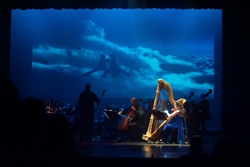
ANNA MARIA & TANGO DEL CIELO
"Another Success for the Rapides Symphony Orchestra"
Publication: Ticket Central
Alexandria, Louisiana
By Jackson Harmeyer
The Rapides Symphony Orchestra scored another win this Sunday
with Tango del Cielo!
Sunday’s concert was both special and different. From the very moment I walked into Coughlin-Saunders Performing Arts Center, I knew something looked different. It hit me, the curtains were down, and I could not see the musicians as they rehearsed as I am used to at orchestral concerts. This, however, was only the first indication of what was to come as the production itself would feature dancers, a painted backdrop, and a full multimedia presentation. Maestro Zona even donned a stylish fedora and suspenders to go along with the tango theme.
None of this would have mattered much though if the music itself had not been engaging. And, engaging it was! In front of the familiar string players, there sat Anna Maria Mendieta on harp surrounded by her travelling teammates – violinist Thomas Yee, cellist Joseph Hébert, and percussionist Antonio Gomez. With splendid orchestral backing, this foursome of soloists – veritable chamber group – played brilliant music full of tango rhythms and other colorful Spanish and Latin American elements.
Sunday’s concert held many highlights for me. In Act I, the orchestral arrangement of Leyenda de Asturias by Isaac Albéniz was as pulsing and as powerful as the more familiar version for guitar, but here its excitement was amplified by the colorful interchanges between the various instruments. Later, the familiar Bordel-1900 from Astor Piazzolla’s Histoire du Tango – originally for flute and guitar – shone with similar brilliance in its orchestral arrangement. In the Second Act, percussionist Gomez and cellist Hébert played solos of their own invention which were full of intensity too. And, everything ended on an exciting note with the famous Malagueña in an arrangement by Mendieta herself.
I was also overjoyed to learn that the Rapides Symphony Orchestra provided two opportunities for educational outreach while the Tango del Cielo troupe was in town. Saturday, Anna Maria Mendieta led a masterclass with local dance studios all about the tango and flamenco dance idioms. And, on Monday, the Tango troupe and orchestra staged an additional performance of the concert for local public schools. I think music should be a vital part of every child’s education, and that it is essential to introduce classical music to children – an age when people’s minds are still so open to new things. The music lectures I myself have given, I know, have been rewarding as I have watched students’ eyes light-up when they hear music that is unexpectedly familiar. I am thrilled to see the Rapides Symphony Orchestra devoting their time to these educational efforts!
Until next time, hope you listen to some great music!
– Jackson Harmeyer
San José Chamber Orchestra: Invigorating Model of Local, Classical Voice Magazine
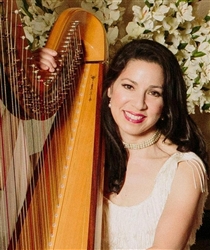
CONCERTO PREMIERE
"San José Chamber Orchestra: Invigorating Model of Local"
Publication: Classical Voice Magazine
By David Bratman
San Jose, CA
The San José Chamber Orchestra, conducted by Barbara Day Turner, lured a near-capacity audience to Le Petit Trianon in downtown San José for a season-opening concert on Sunday, even though the composers featured were not world-famous names, showing that big headliners are not needed for a popular or successful concert.
All the works on the program were written in a variants of a semi-consonant modern style. All were ingratiating works of substance. All three works were concertos of a kind, and the two by the living composers were receiving their first performances.
Pratorius’ Claroscuro en flor was the most conventionally structured of the three, with plenty of unaccompanied passages for the soloist, and dialogues with the orchestra, shaped into the traditional three movements.
The solo instrument, however, was a harp — something a bit unusual, though not unprecedented. Anna Maria Mendieta was the harpist. She was fluent and invigorating. Pratorius, himself a guitarist, had her play some guitar-like plucking sounds, along with a lot of needling away at the highest strings of the instrument, some striking bell-like sounds, and some fingernail strumming that sounded less like a guitar and more like an autoharp.
The work as a whole was primarily modal, without taking particularly after any earlier modal composers to my ear. The orchestration, full and occasionally witty.
"Twist With A Beat", Eagle, Lifestyles. Chadron, Nebraska
(external link)
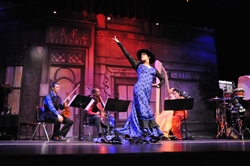
TANGO DEL CIELO
"Twist with a Beat"
Publication: The Eagle -Lifestyles
By Ashley Swanson
Chadron, Nebraska
Intimidating isn’t a strong enough word to describe the group who took the Memorial Hall Stage on Tuesday. With backs straight, and carrying beautifully carved instruments, along with a large array of music chosen for the evening, it was difficult not to stare with wonder.
Anna Maria Mendieta’s Tango del Cielo, which means “Tango from Heaven,” were the first performers in the 2013-14 Galaxy Series. Complete with a harpist, violinist, percussionist, cellist, and a flamenco and tango dancer, the ensemble did not disappoint. The group opened their performance with a piece called “Ave Maria” composed by Astor Piazzolla.
Their fingers gracefully moving across the strings, with the occasional beat of a drum, the group moved from a soft, soothing tune to a more upbeat section. The second piece, “Adios Nonino” composed by Piazzolla, sounded like a group of people preparing for battle; however, as it moved along, the music became softer, with a happier tune.
“What’s exciting for musicians is using the instruments that add to the character of the music,” Anna Maria Mendieta, harpist and dancer, said. She continued on to describe the type of dancing that would take place. Tango, one of the main dances, involves a lot of leg movement. After introducing each member, and what instrument they played, Anna Maria Mendieta explained the warm and crisp tones, as well as the sweeps she made while playing her harp.
Their next piece “Jalousie,” composed by Jacob Gade swiftly turned into something you might find in Paris amongst the glimmering lights, the moon’s reflection off a nearby canal, and the sound of wine glasses clinking after a toast.
Each new piece the group shared with the audience brought a familiar taste, with a surprise tied in. While some pieces were tranquil and romantic, others were adventurous and intricate.
In the second half of their performance, Antonio Gomez, percussionist, wowed the audience with a series of “painted pictures.” He instructed the audience to listen closely to the sounds he made, but also to close their eyes, and so the music would take them some place different.
The first piece began with the sweet sound of rain gently falling. Bird calls could be heard in the distance—some low and deep, while others were high pitched and quick. The rain continued as different levels of crickets and wind filled the empty space of the rainforest.
The second piece began with the chiming of gongs and drums; the beats quick but the echoes seemed to last forever. Soon, drums were shaking the stage. The music continued to get louder,
much like it’s building up to some grand finale, but eventually fades out.
Not skipping a beat, another set of sound fills the stage, this time the tones make you feel as though you’re in a small town and it’s as though a celebration is taking place, and mugs are being filled with their finest drink while people are dancing together, spinning around and around the town’s square.
Throughout the performance, Suzanne Mendieta, a flamenco dancer, and Eldon Bryce, a tango dancer, elaborate each piece with a meaningful dance, which tells the music’s story through a
different light.
Much like the dancers that one could imagine in Gomez’s final piece, Anna Maria Mendieta and Bryce slid
across the floor as if they owned every inch, and planned on using it to their advantage. Each intricate move was specific. No matter which dance they were performing, their moves showed
determination and love for their work.
Suzanne Mendieta adorned the stage in a new outfit with every dance, each dress longer and thicker than the last. Both dancers seemed to feel the music in them instead of around them.
In the final minutes of the event, Bryce juggled between dancing with Suzanne Mendieta and Anna Maria Mendieta, while the other three musicians continue to flick their music into the air.
The standing ovation that greeted the performers was well-deserved as the group took their bows, thanked the audience for coming, and walked off the stage in the same professional, intimidating manner they arrived in.
By Ashley Swanson
Elegant Diversity: Master Sinfonia Chamber Orchestra Concert, Classical Music Guide, CA
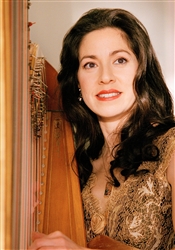
CONCERTO REVIEW
Elegant Diversity: Master Sinfonia Chamber Orchestra Concert
Publication: Classical Music Guide (online)
Northern California
By Gary Lemco
The big work of the afternoon came in the form of the Tango Suite for Harp and Strings, music by Astor Piazzolla arranged by Pablo Zeigler and Daniel Binelli.
Ms. Anna Maria Mendieta is principal harpist of Sacramento Philharmonic, and she plays an eight-pedaled, bright-toned instrument modeled after that custom-made for Nicanor Zabaleta. In the course of her many ravishing glissandi and arpeggiated riffs, she several times in the Piazzolla Suite invoked the Carlos Salzedo "Chanson de la Nuit" that Nicanor Zabaleta himself championed. Piazzolla, a student of Nadia Boulanger, found his “true voice” in the Argentine tango rhythm, which he soon adapted to his personal, jazzy vision in nuevo tango that no less embraces the canto]i] jondo[/i] of traditional Spanish music. The Suite presented us three well-defined movements, opening with "Introduccion al Angel", with cadenzas supplied by Pablo Ziegler and Michael Touchi. The tango rhythm would vie with soli from the first violin, the musical haze assuming an ever increasing erotic component.
Conductor Ramadanoff kept a keen eye on both his ensemble and soloist Mendieta in the course of the intricate proceedings, maintaining a tight leash on the exotic colors in which Piazzolla indulges. "Milonga en el Viento" – Dance of the Wind – presented passing dissonances in the course of subtle, “sirocco” colorations. The last movement, "Libertango", indeed proffered “free” dance impulses tinged by chromatics and polyphony, intricate and accented most vividly. Even one of the brass musicians from the Faure piece, here an audience member like the rest of us, commented to a fellow listener, “This piece is really something!”
Vallejo Symphony Opens In Style, Bencia Herald, Benecia, CA
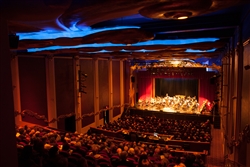
CONCERTO REVIEW
"Vallejo Symphony Opens In Style"
Publication: Bencia Herald,
Benecia, California
Review by Elizabeth Warnimont
The The Vallejo Symphony opened its 81st season Saturday with popular favorites from Mozart and Mendelssohn, plus a more unusual, modern piece by Astor Piazzolla featuring guest soloist Anna Maria Mendieta on solo harp. The concert, held at the Empress Theatre in Vallejo, marked conductor David Ramadanoff’s 30th year with the symphony.
Following the Impresario Overture was an unusual and exciting work, Astor Piazzolla’s “Tango Suite,” an arrangement for solo harp, strings, percussion and bandoneón. Mendieta is a true master of her instrument and in fact dedicated much of her music study to gathering and arranging tango works for the harp. She often incorporates dance into her performances and conductor Ramadanoff would have gladly accommodated but for the limited space available on the Empress stage: “We got the orchestra on with a shoe horn,” the maestro quipped.
The suite begins with a melody played primarily by the harp. Unlike most music composed for harp, Piazzolla’s suite calls for more plucking and less strumming, resulting in a stronger feel and more dominant melodic lines. Mendieta’s performance was exciting and beautiful, and the orchestra was finely tuned to her sound and style.
The violin section came in early in the first movement, with a gentle response to the harp’s theme. The second movement was more march-like, with percussive effects from the string section, striking their instruments for that distinctive tango beat. Moods shifted even within movements, from sad and contemplative to thrilling, with distinct interplay between the harp and the orchestra.
The third and final movement of the suite features an accordion-like instrument, the bandoneón. It is actually more like the concertina than an accordion, having no piano-like keys, only bellows and buttons for sound manipulation. Soloist Seth Asarnow played the part on the instrument that was actually owned and played by the composer. The bandoneón part builds gradually, transforming from a serene, almost hypnotic effect to the ultimate, aggressive tango sound.
“Tango Suite” exemplifies Piazzolla’s unique talent for incorporating influences from various tango forms into a coherent and pleasing sound. His music was not initially well received, according to symphony board member Mary Eichbauer, but by the 1950s it was “all the rage,” most notably in France. It hit the U.S. in a wave of popularity by the 1980s.
Tango Surprises From The Sky; Suislaw News, Florence, OR
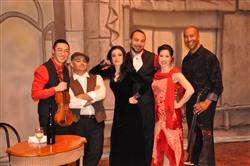
TANGO DEL CIELO
"Tango Surprises From The Sky"
Publication: Suislaw News,
Florence, Oregon
By Burney Garelick
The music was sweet and sad, bowed, plucked, and percussed with refined elegance. Nothing like the sound tango evokes - no sultry, smoldering chords, twisting long limbs in manipulative moves of menace.
If Tango del Cielo's music was pretty, tango dancer Count Glover's countenance smoldered with enough dark intensity to shake the continent of South America, spilling tsunami waves in all directions. Flamenco dancer Fanny Ara was equally chilling, clicking castanets and stomping the stage giving rise to the phoenix. Count and Fanny attempted to dance with each other but were both put off and exited at opposite sides, two titans of terror unwilling to engage each other. Count plucked harpist Anna Maria Mendieta from her instrument and put her through intricate twists and turns, after which he dropped her at her harp and fled the stage. Sometimes he danced by himself, pleased at last to find a perfect partner.
Anna Maria, however, knew what to expect and expertly dodged bullets that would send anyone else to a chiropractor. Anna Maria is genetically coded for tango; her great aunt danced in Rudolph Valentino's silent movie classics.
Tango del Cielo, an ensemble from California and Seattle, performed April 13 at the Florence Events Center, the penultimate concert in the Seacoast Entertainment Association 2011-12 season series. The four musicians celebrated traditional tango and flamenco using classical instrumentation violin, cello, and harp and extraordinary percussion, all arranged with complementary precision. Much of the program of Latin music was drawn from the work of Astor Piazzolla.
Readily recognizable pieces included "Jalousie," "Granada," and "Malagueña." Dancers accompanied some of the pieces. "Danse Espagnole from La Vida Breve" by Manuel de Falla and transcribed for violin by Fritz Kreisler was a literally moving duet between flamenco dancer Fanny and violinist Thomas Yee. Thomas is an excellent violinist, and his fiddle, previously owned by the great Isaac Stern, has a sublime tone, even when it is tasked to imitate crickets.
The innovative group provided other surprises, including video clips on a large screen of Valentino films and colorful artwork to accompany the music. At the start of the second set, the group performed its own silent film against an elaborate stage set. The Count sat at a cafe table drinking wine and feverishly writing a music score. Percussionist Antonio Gomez was a put-upon waiter. Anna Maria arrived to discover the composer's score and played it on her harp. She showed the score to cellist Joseph Hebert who turned it right side up or upside down and played it on his instrument. Thomas appeared wearing a black fedora and toting his cased instrument like a gangster's weapon. 'Twas truly a tango film noir!
Drum solos in any genre are always exciting, but Antonio's "Madera y Cuero" was mesmerizing. He had no traditional drum kit; he sat on a box drum and combined bongos, cymbals, shakers, rattles, a rainstick, and all manner of percussive implements. The string instruments joined in with exotic sounds, enveloping the listener in a tropical landscape by painter Henri Rousseau arranged by John Cage.
Tango del Cielo delivered an innovative and surprising performance of tango and flamenco music. Rain isn't the only thing that falls from the sky!
"Latina Style" Magazine: Latinas in Music - Artistic Excellence (National Publication)
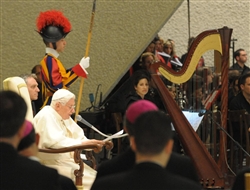
FEATURED STORY
Latina Style Magazine (National Publication)
Latinas in Music, Artistic Excellent
By Mark Holston
The trappings of success in the music business come in many forms. In the case of Anna Maria Mendieta, a San Francisco-based harpist whose artistry embraces a broad range of classical and popular idioms, being tapped to perform for the King and Queen of Spain and the Pope is a clear sign of her growing international stature.
Each of these young Latinas is a living reminder of how raw talent, melded with focused ambition and leavened with an expansive supporting network of family, friends, and mentors, can propel artists to the upper echelon of their craft. And all three realize just how serendipitous their ascension has been.
For Anna Maria, whose background includes backing a diverse constellation of pop music stars, from Barry Manilow to Olivia Newton John and Frank Sinatra, Jr., per-forming with the legendary rock group Moody Blues was a watershed event. “I remember having a very surreal mo-ment while in concert with that group,” she recalls. “We were playing ‘Nights In White Satin’, and, in the middle of the song, I flashed back to when I was a little girl listening to that song on the oldies radio station in the back of our family station wagon.” Just a kid, Anna Maria nonetheless noticed the beautiful harp solo in the tune. “I was thinking how cool it was to add classical instruments to rock music,” she adds. “I listened so carefully; I wanted to memorize every note. I was hypnotized by the music. And then to be, years later, on stage with Moody Blues, with the lights, fog, effects, the screaming fans, I was in awe of the fact that now I was playing that beautiful harp part! Dreams do come true!”
Anna Maria’s personal story reflects the deep involvement in music of her extended family. Her father plays the guitar while her mother’s instrument is the accordion. The couple met through their music and virtually everyone in the family plays an instrument. Anna Maria is also giving several of her nieces harp lessons.
While her family traces its lineage to Spain, in the New World there were branches in both Mexico and Guatemala. “My Mexican grandmother lived with us until I was 18, and only spoke Spanish,” she recalls of her early childhood. “We’d see my Guatemalan grandmother four times a week, as she would come over to help my mother with the kids or the laundry. Both would cook, and tell stories, and share their cultures with us in many ways. And what stories indeed! My Mexican grandmother’s grandfather was a general. His son became a symphony conductor, another became a concert violinist, and one of my grandmother’s brother’s really did run away to join the circus.”
Her Guatemalan grandmother came to San Francisco to start a new life, her father having been a tobacco plantation owner lost everything because of being on the wrong side of an incoming government. “He sent his wife and daughters to the U.S. to be safe and have a new beginning,” Anna Maria affirms. “My grandmother was a flapper in the 1920’s and met my grandfather at a dance. He was from Cadiz, Spain and was an artist. She was beautiful and looked like a movie star; in fact one of her relatives became one, and starred with Rudolph Valentino in the silent movies.”
For Anna Maria, every day seems to bring another surprising development in her career. Recently, the American Harp Society co-commissioned a concerto featuring Latin American rhythms to be composed for her, with performances al-ready scheduled with three symphony orchestras next year. It’s another example of how this charismatic young harpist has impressed so many across the entire spectrum of classical and popular music styles. After all, none other than Barry Manilow called her his “favorite harpist.”
“Many years ago,” she recalls, “I played for several of Barry’s touring shows, and I was told by his assistant just before the first performance that he would introduce all of the instrumentalists and ask them to play a little something. He probably expected just a little strum from the harpist, but when it came to my turn, I remember that I was very nervous inside not having anything planned. I played something very showy, hamming it up quite a bit. I think it caught everyone by surprise, because I remember Barry stopped, and with a big smile, chuckled and nodded approvingly!”
Anna Maria has also developed a passion for Argentina’s tango, a style previously unexplored by a harpist. “In 2005, in order to understand the music better,” she recounts, “I took tango dancing lessons and, what an eye opener! The music now made sense; I was learning how to be grounded and connect with the earth. We, as musicians, also have to become like dancers and be so intuitively sensitive to one another.” Her tango explorations led to associations with masters of the genre, the formation of her own touring group, Tango del Cielo, and an upcoming recording project to highlight her new expertise.
(Outreach Program) "A Morsel of World Music"; The Bulletin, Redmond, Oregon
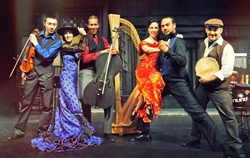
TANGO DEL CIELO
"A Morsel of World Music"
Spanish Themed Concert Inspires Redmond Students
Publication: The Bulletin,
Redmond, Oregon
By Megan Kehoe
Though Sage Elementary School students in Redmond had just returned from Spring Break, they were already being whisked away to foreign lands last week with a concert featuring classical music from Spain, Argentina and other Spanish speaking countries.
"Most of these kids have never seen someone playing the harp, let alone a live classical concert, said Geri Gunderson of the Redmond Community Concerts Association. "And they're getting to hear such wonderful music."
The concert featured harpist Anna Maria Mendieta along with a classical music ensemble. Their performance of Spanish and Argentine-infused music treated students to both a musical and cultural experience that Monday morning. students even watched their principal, Carolyn Espinoza, dance a tango - a sight that had many of them smiling and giggling.
The Redmond Community Concert Association has operated an outreach program for 17 years, sending visiting artists and musicians into Redmond schools, Gunderson said. Last week's concert at Sage was held in the gymnasium, with the entire student body present.
The musicians started the concert with a "Buenos Dias". Many of the students, understanding the Spanish words for "Good Morning" responded by repeating the phrase.
Musician Tony Gomez talked to the students about Spanish, asking them which countries use it as their main language.
"California!", one student near the front row shouted. Teachers and students laughed at the response. He told the student he wasn't altogether wrong - while many people in California do speak Spanish, California is not a country.
Other responses were Mexico and Spain. He added several others to the list, and explained that the music the ensemble would play comes from many of those countries.
"I've never been to a classical music concert before", said Brianna Hamilton, 10. "So I think it'll be interesting."
The concert began with a piece by Spanish composer Manuel De Falla. As Mendieta gracefully plucked her harp, Thomas Yee cut away furiously at the violin.
Midway through the piece, dancer Suzanne Mendieta, Anna's sister, emerged from behind the stage dressed in a canary-yellow flamenco dress.
Yee joined her on the floor, matching her graceful movements while continuing to play the violin. reactions of "Whoa!" and "Cool!" erupted from the audience.
"It's so much fun to see the kids' expressions." said Diana Barker, RCCA president.
After receiving a round of applause, performers talked to students about the diversity of the local culture in Redmond, and how the confluence of cultures was comparable in some ways to many Latin American countries, including Argentina.
The next piece the musicians played was an Astor Piazzolla tango. Mendieta left her harp midway through the piece to dance a tango with another dancer who emerged from behind the stage.
"The dancing is awesome." said Gaby Smith, 10. "I like that if you close your eyes, you can hear a different place."
The performance was topped off with a tango number featuring one of the dancers and a surprised Espinoza, who hadn't expected to be learning how to tango in front of the student body.
"It's really amazing," said Eve Williams, 11. "I just love the way the music sounds."
Barker said such concerts can spur an interest in music that students carry with them for life.
"It gives them an exposure to a kind of music that they wouldn't otherwise see," Barker said. "Most artists were their age when they were first exposed to music-and it's the that one brief contact that can set them on their way."
- by Megan Kehoe mke@bendbulletin.com
Chamber Orchestra Evokes Intensity, Lushness of Tango; American Symphony Orchestra League & San Jose Mercury News
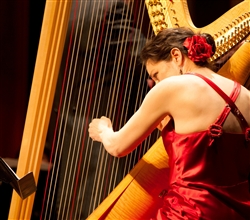
CONCERTO PREMIERE!
Published Internationally:
LEAGUE OF AMERICAN ORCHESTRAS "In The News"
"Chamber Orchestra Evokes Intensity, Lushness of Tango"
Publication: San Jose Mercury News,
San Jose, California
By Richard Scheinin
Conductor Barbara Day Turner touches on tango from time to time. It's natural for her. It's natural. She's married to an Argentine, travel's to Buenos Aires with some regularity and clearly is inspired by the city's signature music. Audiences loves that stuff.
No surprise then that day turner and the San Jose Chamber Orchestra began their season with a nearly sold out, tango infused program Sunday at Le Petit Trianon.
The yearning sound of the bandoneon, the button-and-bellowes squeezebox (a cousin of the accordion) that pretty much defines tango, was all over the concert's festive second half. So was the harp, not so familiar in tango orchestras, but sounding lusciously at home in arrangements of works by Astor Piazzolla and Pablo Zeigler.
The program was given an extra boost by two exceptional soloists, harpist Anna Maria Mendieta and bandoneon wiz Seth Asarnow.
Asarnow's playing, at once edgy, lyrical and conversational. This sort of easy virtuosity is an illusion, inasmuch as the bandoneon is a wickedly difficult instrument with its double keyboard and myriad of buttons. Nearly every one of those buttons produces two different notes, depending on whether the bellows are opening or closing.
Following Asarnow came Mendieta, who, if anything was even more impressive.
A charismatic player, she ranged through her instrument: exquisite, finger-flicked dustings up and across the strings; or guitar-like strums, crisp and percussive; or rich-blooded low notes or brilliant high ones. She also contributed (along with Ziegler and Michael Touchi) to the arrangements of Piazzolla's "Introduccion al Angel" (ballet music about an angel descending on Buenos Aires) and Ziegler's "Milonga en el Viento" (which recalls Ivan Lins' "Semptembro").
This was a crowd-pleasing suite with its sweeping song and Piazzollan counterpoint. The interwoven sound of Mendieta (principal harp with the Sacramento Philharmonic) and the orchestra often was luminous. The effect continued with Piazzolla's "Libertango", which featured both Mendieta and Asarnow as soloists -- and found Day Turner actually jumping during one rhythmically charged passage. The orchestra played as if it cared about the music.
(Concert review. Record: 0708300122)